www.oprfid.com sales02@oprfid.com
Small, inexpensive radio frequency ID chips are currently mostly a means of efficiency and convenience, but are increasingly controversial. RFID chips transmit a package of data when activated by a radio signal. This introduces electronic interference, data risks and electromagnetic energy exposure concerns. As their use expands dramatically, RFID safety is becoming a balancing act.
Uses
Using RFID chips helps speed and coordinate factory, hospital, retail, industrial and government operations. They are useful for tracking and identifying shipments, equipment, perishable items, retail stock, medical equipment, even hospital patients. The tiny chip can be part of a tag or bracelet, or even inserted under the skin for chronic disease patients.
Risks
Radio signals involved in RFID use can expose humans to electromagnetic radiation on a daily basis. A 2008 article in the Journal of the American Medical Association reported that RFID radio signals can interfere with the operation of some medical equipment. Data transmitted can be captured and used, enabling identity theft.
Benefits
RFID devices provide large-scale benefits by reducing inventory costs, tracking expensive equipment, identifying patients and medications in busy hospitals, and providing fast, effective international border crossings. RFID devices can significantly improve efficiency and security in organizations, so there is a growing push to put them into wide use.
Protections
Protections include keeping open-area use to a minimum, limiting non-encrypted data kept on the device, and avoiding use close to the human body. Some organizations planning to use RFID technology over the last decade have delayed plans because of social, safety and business concerns. Research studies continue to identify and provide ways to minimize the risks of RFID use.
- Related news
- RFID product labels (1人浏览)






